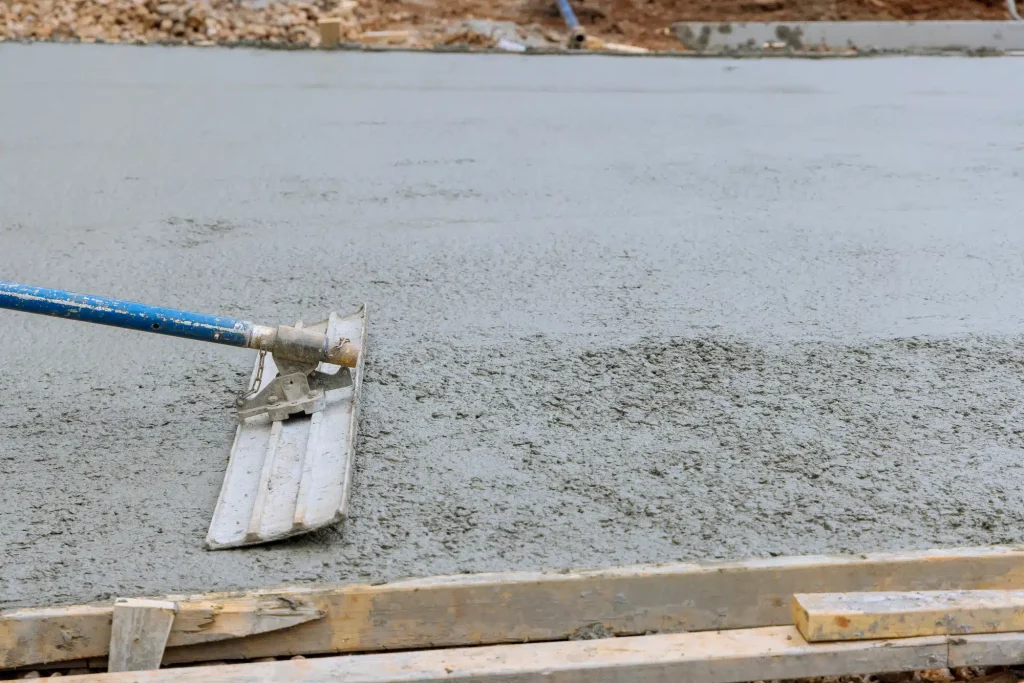Relative humidity (RH) is a critical factor to consider when applying coatings to concrete surfaces. RH refers to the amount of moisture in the air relative to the maximum amount of moisture the air can hold at a given temperature.
In the context of concrete coatings, RH levels within the concrete substrate can significantly impact the coating’s curing process and final performance. Concrete is a highly porous material that can absorb and release moisture from its surroundings.
As such, it is crucial to understand the moisture content within the concrete substrate and the ambient environment during the coating application process. Failure to consider RH levels can lead to coating defects, such as bubbles, blisters, and delamination, compromising the coating’s protective and aesthetic properties.
Therefore, it is essential to maintain optimal RH levels during coating application to ensure the coating’s proper adhesion, curing, and performance.
The Importance of Relative Humidity in Concrete Coatings
The consideration of relative humidity levels is crucial in concrete coatings as it directly impacts the adhesion, curing time, and overall quality of the coating, thereby emphasizing the significance of monitoring and controlling RH levels during the application process.
Relative humidity refers to the amount of moisture in the air compared to the maximum amount of moisture that the air can hold at a specific temperature. When coating concrete surfaces, the RH levels of the environment can significantly affect the coating’s performance.
High levels of relative humidity can cause issues with coating adhesion, leading to the formation of blisters or bubbles on the surface. This is because the high moisture content in the air can interfere with the coating’s chemical bonding process.
Conversely, low RH levels can cause the coating to dry too quickly, leading to inadequate curing and reduced coating performance. Therefore, it is essential to ensure that the RH levels in the environment are within the recommended range for the specific coating being applied.
The importance of relative humidity levels in concrete coatings cannot be overstated. The appropriate RH levels must be maintained to achieve optimal coating performance. Monitoring and controlling humidity levels during the application process can help ensure that the coating adheres well, cures correctly, and provides long-lasting protection to the concrete surface.
How RH Affects Coating Application
Impacted by atmospheric moisture levels, the drying process of coating application is similar to a dance where balance is key. The relative humidity (RH) plays a critical role in this process, as it can significantly affect the coating’s performance and durability. RH is a measure of the amount of moisture in the air compared to the maximum amount the air can hold at a particular temperature.
When applying coatings, the RH should be within the recommended range to ensure proper adhesion and avoid issues such as blistering, cracking, and delamination. RH affects coating application in several ways. Firstly, high RH levels can slow down the drying process, leading to extended curing times and reduced productivity. Secondly, high RH can cause moisture to condense on the surface, leading to poor adhesion and reduced coating performance. Thirdly, low RH levels can cause the coating to dry too quickly, leading to inadequate wetting of the surface and reduced adhesion.
Therefore, it is crucial to monitor the RH levels during coating application and ensure that they remain within the recommended range to achieve the desired coating performance. To mitigate the effects of RH on coating application, several measures can be taken. Firstly, the surface temperature should be maintained at or above the dew point to prevent moisture from condensing on the surface. Secondly, dehumidifiers can be used to reduce the RH levels in the application area. Thirdly, coatings with higher solvent content can be used to reduce the impact of high RH levels.
In conclusion, RH is a critical factor to consider during coating application, and proper measures should be taken to ensure that the RH levels remain within the recommended range to achieve optimal coating performance and durability.
Understanding Moisture Content in Concrete
Moisture content in concrete is a critical factor that affects its durability and performance in various applications. Concrete is essentially a porous material that readily absorbs moisture from its surroundings. The amount of moisture absorbed by concrete is influenced by various factors such as the relative humidity (RH) of the environment, temperature, and the type of concrete used.
The moisture content of concrete is an important consideration in the application of coatings, as excessive moisture can cause coatings to fail. The use of coatings on concrete is a common practice to improve its aesthetics, durability, and resistance to chemicals and abrasion. Coatings do not adhere well to damp surfaces, and excessive moisture can cause coatings to lift, bubble, and peel. Therefore, it is crucial to measure the moisture content of concrete before applying coatings to ensure that the surface is dry enough to accept the coating.
There are various methods for measuring the moisture content of concrete, such as the use of moisture meters, calcium chloride tests, and relative humidity testing. Relative humidity testing is considered the most accurate and reliable method for measuring the moisture content of concrete. This method involves drilling a hole into the concrete and inserting a probe that measures the RH of the internal atmosphere.
Understanding the moisture content of concrete is essential for ensuring the success of coating applications and the longevity of concrete structures.
Avoiding Defects in Coating Due to Moisture
Preventing defects in coating applications due to excessive moisture levels is crucial for ensuring the longevity and optimal performance of concrete structures. Moisture can cause a range of issues, including blistering, peeling, and delamination, which can compromise the integrity of the coating and the underlying concrete. To avoid these defects, it is essential to understand the factors that contribute to moisture in concrete and take appropriate measures to mitigate them.
One effective way to prevent moisture-related defects is to use a moisture barrier coating. These coatings are designed to create a barrier between the concrete and the coating, preventing moisture from penetrating the surface. There are several types of moisture barrier coatings available, including epoxy, polyurethane, and acrylic coatings. The choice of coating will depend on the specific requirements of the project, such as the level of moisture present, the type of concrete, and the intended use of the structure.
Another important factor to consider when applying coatings to concrete is the relative humidity (RH) level. RH is a measure of the amount of moisture in the air compared to the maximum amount of moisture that the air can hold at a given temperature. High RH levels can lead to condensation on the surface of the concrete, which can cause the coating to fail. To avoid this, it is important to monitor the RH levels during the coating application process and take appropriate measures to control the environment, such as using dehumidifiers or ventilation systems. By taking these steps, it is possible to ensure that coatings are applied correctly and that they provide the necessary protection against moisture-related defects.
| Type of Coating | Advantages | Disadvantages | Applications |
| Epoxy | Excellent adhesion, chemical resistance, and durability | Can be brittle and prone to cracking, limited UV resistance | Industrial floors, parking garages, and other high-traffic areas |
| Polyurethane | Good flexibility, abrasion resistance, and UV resistance | Can be expensive, may require multiple coats | Commercial and industrial roofs, bridges, and other structures exposed to the elements |
| Acrylic | Easy to apply, good color retention, and UV resistance | Limited chemical resistance, may require frequent maintenance | Decorative concrete, pool decks, and other non-industrial applications |
Best Practices for Maintaining Optimal RH Levels during Coating Application
Maintaining optimal relative humidity levels during the application of protective coatings to surfaces is crucial for ensuring the effectiveness and durability of the coatings. Relative humidity (RH) is the amount of moisture in the air compared to the maximum amount of moisture that can be held at a specific temperature. High RH levels can cause defects in coating, such as blisters or bubbles, while low RH levels can result in poor adhesion and slow curing times.
To maintain optimal RH levels during coating application, it is essential to monitor the humidity levels of both the air and surface being coated. This can be done using a humidity meter or a moisture vapor transmission test. Additionally, it is recommended to maintain a consistent temperature and airflow in the room to avoid any moisture buildup.
One best practice for maintaining optimal RH levels is to control the moisture exposure of the surface being coated. This can be achieved by using a moisture barrier or by sealing any porous surfaces. Another best practice is to use a coating system that is specifically designed for the environmental conditions of the project. Coating manufacturers often provide guidelines for optimal RH and temperature levels during application, which should be followed closely to ensure the best results.
By implementing these best practices, the likelihood of defects in coating due to moisture can be greatly reduced, leading to a more effective and durable protective coating.
Frequently Asked Questions
What are the most common types of concrete coatings used in the industry?
Concrete coatings are commonly used in the industry to protect and enhance the performance of concrete surfaces. There are several types of coatings available, including epoxy, polyurethane, acrylic, and polyaspartic.
Epoxy coatings are known for their durability and resistance to chemicals, making them suitable for high-traffic areas. Polyurethane coatings offer excellent UV resistance and are often used in outdoor applications.
Acrylic coatings are popular for their fast-drying properties and ease of application. Polyaspartic coatings are gaining popularity due to their fast cure times and ability to withstand extreme temperatures.
It is worth noting that humidity, temperature, and surface preparation play a vital role in the effectiveness of concrete coatings.
In conclusion, the most common types of concrete coatings used in the industry are epoxy, polyurethane, acrylic, and polyaspartic, each with unique properties that make them suitable for different applications.
How do you prepare a concrete surface for coating application?
To prepare a concrete surface for coating application, it is important to first assess the condition of the surface and identify any areas that may require repair or cleaning. This can be done through a visual inspection and various tests such as moisture content and pH levels.
Once any necessary repairs have been made and the surface has been thoroughly cleaned, it should be allowed to dry completely before applying the coating. This can be achieved by using fans or dehumidifiers to remove any remaining moisture from the surface.
Additionally, it is important to ensure that the surface is free of any contaminants such as oil or grease, as these can hinder the adhesion of the coating.
By properly preparing the concrete surface, the coating can adhere more effectively and provide long-lasting protection.
Is there a difference between indoor and outdoor concrete coatings?
Yes, there is a significant difference between indoor and outdoor concrete coatings.
Indoor coatings are typically designed to enhance the appearance of a concrete surface and protect it from foot traffic, stains, and abrasion. These coatings are generally thinner and less durable than outdoor coatings, as they do not have to withstand harsh weather conditions or exposure to UV rays.
Outdoor coatings, on the other hand, are thicker and more durable, as they have to withstand exposure to extreme temperatures, rain, snow, and other environmental factors. They are also designed to provide slip-resistance and prevent water from penetrating the surface, which can cause cracking and other forms of damage.
Ultimately, selecting the right type of coating for your concrete surface depends on a variety of factors, including the intended use of the surface, the level of foot traffic it will receive, and the climate in which it is located.
Can concrete coatings be applied over existing coatings or do they need to be removed first?
Concrete coatings are a popular solution for protecting and enhancing the appearance of concrete surfaces. When it comes to reapplying coatings to an existing surface, it is important to consider whether or not the existing coating needs to be removed first.
In most cases, it is recommended to remove the existing coating before applying a new one, as this ensures proper adhesion and durability. However, there are some instances where a new coating can be applied over an existing one, provided that the old coating is in good condition and the new coating is compatible with it.
In order to determine whether or not an existing coating can be overlaid, it is important to conduct a thorough inspection of the surface and consult with a professional. By taking the time to assess the condition of the existing coating and select the appropriate product for the job, it is possible to achieve a long-lasting, high-quality finish.
How long does it take for concrete coatings to cure and become fully effective?
The curing time for concrete coatings varies depending on the type of coating being used and the environmental conditions in which it is being applied. Typically, it takes anywhere from 24 to 72 hours for a concrete coating to cure and become fully effective.
However, it is important to note that even after the initial curing period, the coating may continue to cure and strengthen over the following weeks and months. It is crucial to follow the manufacturer’s instructions and recommendations for curing times and conditions to ensure the coating is able to achieve its intended performance and longevity.
While the question of what RH stands for in concrete coatings may be relevant to the topic, it is not directly related to the current question of curing time and should therefore not be included in this answer.
Conclusion
Relative humidity (RH) is a critical factor in the successful application of concrete coatings. The moisture content of the concrete substrate can significantly impact the adhesion, curing, and overall performance of the coating. Thus, understanding RH is vital to avoid defects and ensure long-lasting results.
RH affects coating application by influencing the evaporation rate of solvents and water within the coating. If the RH is too high, the coating may not dry or cure correctly, leading to bubbling, cracking, or peeling. Conversely, if the RH is too low, the coating may dry too quickly, resulting in an uneven finish.
To maintain optimal RH levels during coating application, it is essential to monitor the moisture content of the concrete substrate. Surface moisture meters and in-situ probes can help determine the RH and ensure the coating is applied under the right conditions. Additionally, controlling the environmental conditions, such as temperature and ventilation, can also contribute to achieving the desired RH.
In conclusion, RH plays a crucial role in the success of concrete coatings. Without proper consideration and management of RH, the coating’s performance and durability can be compromised. It is essential to adopt best practices and techniques to ensure optimal RH levels are maintained during coating application. As they say, ‘the devil is in the details,’and in the case of concrete coatings, an in-depth understanding of RH is necessary to achieve a flawless finish.

 CALL US NOW
CALL US NOW



